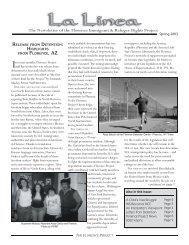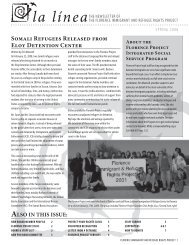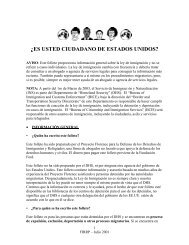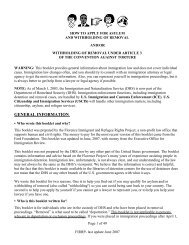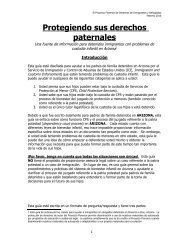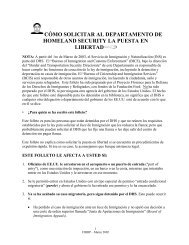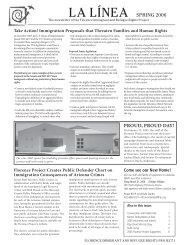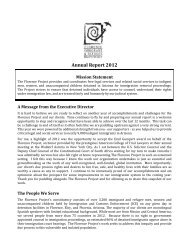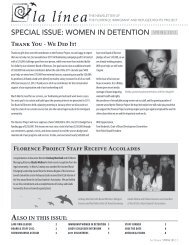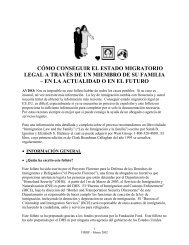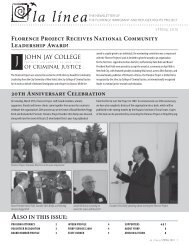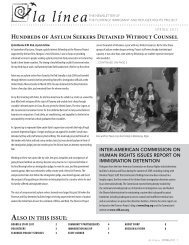quick reference chart and annotations for determining immigration ...
quick reference chart and annotations for determining immigration ...
quick reference chart and annotations for determining immigration ...
You also want an ePaper? Increase the reach of your titles
YUMPU automatically turns print PDFs into web optimized ePapers that Google loves.
Immigrant Legal Resource Center, Florence Immigrant <strong>and</strong> Refugee Rights Project,<br />
Maricopa County Public Defender August 2012<br />
In Huerta-Guevara v. Ashcroft, 321 F.3d 883, 887 (9th Cir. 2003), the Ninth Circuit held a<br />
conviction under A.R.S. § 13-1802 was divisible <strong>for</strong> this purpose in at least two ways. First, some<br />
subparts include the theft of services as opposed to property (see A2, A3 <strong>and</strong> A6). Second, some subparts<br />
do not require an intent to deprive the owner, either temporarily or permanently (see A2, A4 <strong>and</strong> A5).<br />
The Ninth Circuit also found that identically worded subparts of §13-1814, theft of means of<br />
transportation, do not constitute theft <strong>for</strong> this purpose. Nevarez-Martinez v. INS, 326 F.3d 1053, 1055<br />
(9th Cir. 2003).<br />
Counsel should not plead to A5, as receiving stolen property under a similar Cali<strong>for</strong>nia statute has<br />
been held to be an aggravated felony under 8 U.S.C. § 1101(a)(43)(G). Matter of Cardiel, 25 I&N Dec.<br />
12 (BIA 2009); Verdugo-Gonzalez v. Holder, 581 F.3d 1059, 1060 (9th Cir. 2009). However,<br />
<strong>immigration</strong> counsel may have an argument that A5 is broader than the Cali<strong>for</strong>nia statute since A5<br />
includes not only “knowing” but “having reason to know” that the property was stolen. Defense counsel<br />
should avoid any <strong>reference</strong> to the client “knowing” that the property was stolen or else leave the language<br />
of the plea vague.<br />
Until the tension in the Ninth Circuit is resolved as to whether one may infer a criminal intent<br />
where the statute requires only “knowing,” the safest plea <strong>for</strong> theft would leave open the possibility that<br />
defendant stole services (i.e. judgment / indictment recite boilerplate statutory language thus leaving open<br />
possibility that defendant stole services or merely refers to 13-1802 without mentioning a specific<br />
subsection). Also, counsel should avoid a plea to A1, which the Ninth Circuit found to constitute a theft<br />
offense. Fern<strong>and</strong>ez-Ruiz v. Gonzales, 468 F.3d 1159, 1170 (9th Cir. 2006).<br />
Theft by material misrepresentation. The BIA recognizes the essential difference between theft<br />
(by stealth) <strong>and</strong> fraud or deceit (by trickery). Matter of Garcia-Madruga, 24 I&N Dec. 436 (BIA 2008).<br />
Section A3 is by trickery, not stealth, <strong>and</strong> there<strong>for</strong>e it is likely that it will not be considered theft <strong>and</strong> a<br />
sentence of a year or more will not make it an aggravated felony. Where a sentence of a year or more<br />
cannot be avoided, attempt to leave the record of conviction vague between A3 <strong>and</strong> other sections, or<br />
designate A3. As always, in case this argument does not prevail it is far better to obtain 364 days on any<br />
single count.<br />
Note that a crime involving fraud or deceit is an aggravated felony under 8 USC §<br />
1101(a)(43)(M)(i) if the victim/s loss exceeds $10,000, regardless of whether the amount appears in the<br />
record of conviction. See Nijhawan v. Holder, 129 S. Ct. 2294 (2009). Regarding proof of $10,000 loss,<br />
see Note: Fraud. If the $10,000 loss will be established, but a sentence of a year or more will not be<br />
imposed, leave the record of conviction vague between A3 <strong>and</strong> the other theft sections, or designate some<br />
section other than A3.<br />
Crime Involving Moral Turpitude: Intent to permanently deprive is required <strong>for</strong> a CMT. Theft<br />
offenses that do not involve intent to permanently deprive the owner of the property are not classified as<br />
theft crimes involving moral turpitude. See e.g. Matter of P, 2 I&N Dec. 887 (BIA 1947); Matter of M, 2<br />
I&N Dec. 686 (BIA 1946) (conviction <strong>for</strong> joyriding does not involve moral turpitude because defendant<br />
did not intent to effect a permanent taking). Theft offenses that require as an essential element the intent<br />
to permanently deprive the owner of his or her property have consistently been held to involve moral<br />
turpitude. Gutierrez-Chavez v. INS, 8 F.3d 26 (9th Cir. 1993).<br />
Where a theft statute prohibits both temporary <strong>and</strong> permanent taking, the statute is considered<br />
divisible, allowing the record of conviction to be examined to determine whether the conviction was<br />
under the portion of the statute relating to permanent taking. ARS § 13-1802 is arguably a divisible<br />
Arizona Criminal Chart with Explanatory Endnote – August 2012<br />
56



